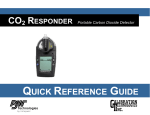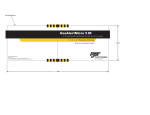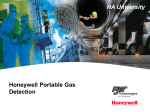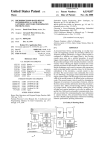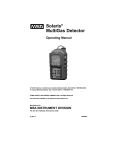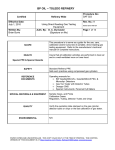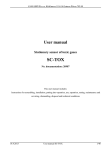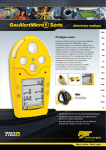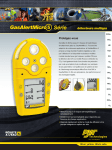Download GasAlertMicro5 Quick Reference Guide, English
Transcript
1, 2, 3, 4, and 5 Gas Detector 50105442-036 English ©BW Technologies 2013. All rights reserved. Quick Reference Guide GasAlertMicro 5/PID/IR Table of Contents Limited Warranty and Limitation Liability .............. 0 Contacting BW Technologies by Honeywell ......... 0 Introduction .............................................................. 1 Safety Information - Read First ............................... 1 Sensor Poisons and Contaminants ........................ 4 Parts of the GasAlertMicro 5/PID/IR ....................... 5 Display Elements ..................................................... 6 Pushbutton ............................................................... 7 Connecting the Gas Cylinder to the Detector ....... 7 Single Gas Calibration Cap ..........................................8 Removing the Cap .................................................... 8 Pump ......................................................................... 9 Identifying the Pump .....................................................9 Generation 1: 116885-L3 (yellow) and 118933-L3 (black) ....................................................................... 9 Generation 2: 130916-L3* (yellow) and 130917-L3 (black) ....................................................................... 9 Pump Features ...........................................................10 Pump Alarm ................................................................10 Confined Space Sampling ..........................................10 Maximum Hose Length when Confined Space Sampling ................................................................. 11 Alarms ..................................................................... 15 User Options Menu ................................................ 18 Maintenance ........................................................... 19 Replacing Battery Cells and Packs ...................... 20 Replacing Alkaline Batteries .......................................21 Replacing Lithium Battery Packs ................................22 WEEE Directive and Battery Directive ........................22 Removal and Disposal of the Battery Pack............. 22 Removal and Disposal of the Coin Cell................... 23 Replacing a Sensor or Sensor Filter ...........................25 Replacing the Pump Filter (Generation 2 Pump only) ............................................................................26 Replacing the Pump Nozzle (Generation 2 Pump only) ............................................................................26 Specifications ......................................................... 27 Information Required for European Regulations Compliance ............................................................. 30 Tested Sensors ....................................................... 32 Performance Data According to EN 45544 Part 1 and 2 ....................................................................... 32 Troubleshooting ..................................................... 33 Replacement Parts and Accessories ................... 39 Bump Test ............................................................... 12 Performing a Bump Test .............................................12 Calibration .............................................................. 13 i Limited Warranty and Limitation Liability BW Technologies LP (BW) warrants the product to be free from defects in material and workmanship under normal use and service for a period of two years, beginning on the date of shipment to the buyer. This warranty extends only to the sale of new and unused products to the original buyer. BW’s warranty obligation is limited, at BW’s option, to refund of the purchase price, repair or replacement of a defective product that is returned to a BW authorized service center within the warranty period. In no event shall BW’s liability hereunder exceed the purchase price actually paid by the buyer for the Product. This warranty does not include: a) fuses, disposable batteries or the routine replacement of parts due to the normal wear and tear of the product arising from use; b) any product which in BW’s opinion, has been misused, altered, neglected or damaged, by accident or abnormal conditions of operation, handling or use; c) any damage or defects attributable to repair of the product by any person other than an authorized dealer, or the installation of unapproved parts on the product; or The obligations set forth in this warranty are conditional on: a) proper storage, installation, calibration, use, maintenance and compliance with the product manual instructions and any other applicable recommendations of BW; b) the buyer promptly notifying BW of any defect and, if required, promptly making the product available for correction. No goods shall be returned to BW until receipt by the buyer of shipping instructions from BW; and c) the right of BW to require that the buyer provide proof of purchase such as the original invoice, bill of sale or packing slip to establish that the product is within the warranty period. THE BUYER AGREES THAT THIS WARRANTY IS THE BUYER ’S SOLE AND EXCLUSIVE REMEDY AND IS IN LIEU OF ALL OTHER WARRANTIES, EXPRESS OR IMPLIED, INCLUDING BUT NOT LIMITED TO ANY IMPLIED WARRANTY OF MERCHANTABILITY OR FITNESS FOR A PARTICULAR PURPOSE. BW SHALL NOT BE LIABLE FOR ANY SPECIAL, INDIRECT, INCIDENTAL OR CONSEQUENTIAL DAMAGES OR LOSSES, INCLUDING LOSS OF DATA, WHETHER ARISING FROM BREACH OF WARRANTY OR BASED ON CONTRACT, TORT OR RELIANCE OR ANY OTHER THEORY. Since some countries or states do not allow limitation of the term of an implied warranty, or exclusion or limitation of incidental or consequential damages, the limitations and exclusions of this warranty may not apply to every buyer. If any provision of this warranty is held invalid or unenforceable by a court of competent jurisdiction, such holding will not affect the validity or enforceability of any other provision. Contacting BW Technologies by Honeywell USA: 1-888-749-8878 Europe: +44(0) 1295 700300 Canada: 1-800-663-4164 Other countries: +1-403-248-9226 Email us at: [email protected] Visit BW Technologies by Honeywell’s website at: www.gasmonitors.com GasAlertMicro 5/PID/IR Introduction GasAlertMicro 5/PID/IR Introduction Safety Information - Read First The quick reference guide provides basic information to operate the GasAlertMicro 5, GasAlertMicro 5 PID, and GasAlertMicro 5 IR gas detectors. For complete operating instructions, refer to the GasAlertMicro 5/PID/IR User Manual provided on the CD-ROM. Use the detector only as specified in this quick reference guide and the user manual, otherwise the protection provided by the detector may be impaired. The GasAlertMicro 5, GasAlertMicro 5 PID, and GasAlertMicro 5 IR detectors (“the detector”) are designed to warn of hazardous gas levels above user-defined alarm setpoints. Read the following Cautions before using the detector. Note Unless reference is made to a specific detector model, the GasAlertMicro 5, GasAlertMicro 5 PID, and GasAlertMicro 5 IR detectors are referred to as GasAlertMicro 5/PID/IR. The detector is shipped with English as the default displayed language. Additional languages provided are French, German, Spanish, and Portuguese. The screens for the additional languages are displayed on the detector and in the corresponding quick reference guide. The detector is a personal safety device. It is your responsibility to respond properly to the alarm. a Cautions • Warning: Substitution of components may impair Intrinsic Safety. • Caution: For safety reasons, this equipment must be operated and serviced by qualified personnel only. Read and understand the user manual completely before operating or servicing. • Charge the detector before first-time use. BW recommends the detector be charged after every workday. • Charge the battery pack immediately when a low battery alarm occurs. • Read and adhere to the battery cautions provided in Replacing Battery Cells and Packs on page 20. 1 GasAlertMicro 5/PID/IR Quick Reference Guide • BW recommends that the combustible sensor be checked with a known concentration of calibration gas after any exposure to contaminants/poisons such as sulfur compounds, silicon vapors, halogenated compounds, etc. • BW recommends to bump test the sensors before each day’s use to confirm their ability to respond to gas by exposing the detector to a gas concentration that exceeds the alarm setpoints. Manually verify that the audible and visual alarms are activated. Calibrate if the readings are not within the specified limits. • For an additional bump test caution relating to the European Regulations, refer to page 12. • Calibrate the detector before first-time use and then on a regular schedule, depending on use and sensor exposure to poisons and contaminants. The sensors must be calibrated regularly and at least once every 180 days (6 months). • Calibrate only in a safe area that is free of hazardous gas in an atmosphere of 20.9% oxygen. • Only the combustible gas detection portion of this instrument has been assessed for performance by CSA International. • The combustible sensor is factory calibrated to 50% LEL methane. If monitoring a different combustible gas in the % LEL range, calibrate the sensor using the appropriate gas. • Caution: High off-scale LEL readings may indicate an explosive concentration. 2 • Protect the combustible sensor from exposure to lead compounds, silicones, and chlorinated hydrocarbons. Although certain organic vapors (such as leaded gasoline and halogenated hydrocarbons) may temporarily inhibit sensor performance, in most cases, the sensor will recover after calibration. • For use only in potentially explosive atmospheres where oxygen concentrations do not exceed 20.9% (v/v). Oxygen deficient atmospheres (<10% v/v) may suppress some sensor outputs. • Any rapid up scaling reading followed by a declining or erratic reading may indicate a gas concentration beyond the upper scale limit, which can be hazardous. • Extended exposure of the GasAlertMicro 5, GasAlertMicro 5 PID, or GasAlertMicro 5 IR to certain concentrations of combustible gases and air may stress the detector element that can seriously affect its performance. If an alarm occurs due to a high concentration of combustible gases, recalibration should be performed or, if needed, the sensor replaced. • The BW pump module (M5-PUMP) is certified for use with the GasAlertMicro 5, GasAlertMicro 5 PID, and GasAlertMicro 5 IR models only. • Protect the PID sensor from exposure to silicone vapors. • When calibrating O3 and ClO2 sensors that are located in the Toxic 2 position of the detector, a single gas calibration cap must be used to ensure accurate calibration. GasAlertMicro 5/PID/IR Safety Information - Read First • Replace the sensors only in a safe and non-hazardous area that is free of hazardous gas in an atmosphere of 20.9% oxygen. • Warning: The battery pack (M5-BAT08) is equipped with a lithium battery that may present a risk of fire or chemical burn hazard if misused. Do not disassemble, heat above 212ºF (100ºC), or incinerate. • Warning: Do not use any other lithium batteries that are not designed for use with the GasAlertMicro 5, GasAlertMicro5 PID, or GasAlertMicro5 IR detectors. Use of any other cell can cause fire and/or explosion. To order and replace the M5-BAT07 or the M5IR-BAT08 lithium battery pack, contact BW Technologies by Honeywell. • Warning: Lithium polymer cells exposed to heat at 266°F (130°C) for 10 minutes can cause fire and/or explosion. • Dispose of used lithium cells immediately. Do not disassemble and do not dispose of in fire. Do not mix with the solid waste stream. Spent batteries must be disposed of by a qualified recycler or hazardous materials handler. • Keep lithium cells away from children. • Before using common products around sensors, refer to Sensor Poisons and Contaminants on page 4. • High concentrations of certain toxic gases, for example H2S, may have an adverse effect on the LEL sensor. This effect, known as inhibition, is usually temporary but in extreme circumstances can impair the sensitivity of the LEL sensor. After any gas exposure that causes an alarm in the toxic gas sensors, the LEL sensor should be verified with a bump test, and recalibrated if necessary. The detector contains either alkaline batteries or a lithium polymer battery. Refer to the following warnings. ce Warning This instrument contains alkaline batteries. Do not mix with the solid waste stream. Spent batteries must be disposed of by a qualified recycler or hazardous materials handler. ce Warning This instrument contains a lithium polymer battery. Dispose of lithium cells immediately. Do not disassemble and do not dispose of in fire. Do not mix with the solid waste stream. Spent batteries should be disposed of by a qualified recycler or hazardous materials handler. 3 GasAlertMicro 5/PID/IR Quick Reference Guide Sensor Poisons and Contaminants Several cleaners, solvents, and lubricants can contaminate and cause permanent damage to sensors. Before using cleaners, solvents, and lubricants in close proximity to the detector sensors, read and adhere to the following caution and table. a Caution Use only the following BW Technologies by Honeywell recommended products and procedures: • Use water based cleaners. • Use non-alcohol based cleaners. • Clean the exterior with a soft, damp cloth. • Do not use soaps, polishes, or solvents. 4 The following table lists common products to avoid using around sensors. Cleaners and Lubricants • Brake cleaners • Lubricants • Rust inhibitors • Window and glass cleaners • Dishsoaps • Citrus based cleaners • Alcohol based cleaners • Hand sanitizers • Anionic detergents • Methanol (fuels and antifreezes) Silicones Aerosols • Silicone based adhesives, sealants, and gels • Hand/body and medicinal creams containing silicone • Tissues containing silicone • Mold releasing agents • Polishes • Bug repellents and sprays • Lubricants • Rust inhibitors • Window and glass cleaners GasAlertMicro 5/PID/IR Parts of the GasAlertMicro 5/PID/IR Parts of the GasAlertMicro 5/PID/IR Item Description 1 Liquid crystal display (LCD) 2 Pushbuttons 3 Audible alarms 4 Toxic 2 sensor 5 Toxic 1/PID sensor (GasAlertMicro 5 PID), or Toxic 1/IR (CO2) sensor (GasAlertMicro 5 IR) 6 Visual alarm indicators (LEDs) 7 LEL sensor 8 Oxygen sensor 9 Pushbuttons 10 Battery pack 11 Alligator clip 5 GasAlertMicro 5/PID/IR Quick Reference Guide Display Elements Item 6 Description 1 Alarm condition 2 Automatically span sensor 3 Gas cylinder 4 Gas identifier bars 5 Battery life indicator 6 Passcode lock 7 Data transmission 8 Clock 9 Stealth mode 10 Optional pump indicator 11 Datalog card indicator (optional) 12 Alarm condition (low, high, TWA, STEL, or multi) or view TWA, STEL and peak (MAX) gas exposures 13 Automatically zero sensor GasAlertMicro 5/PID/IR Pushbutton Pushbutton Pushbutton Connecting the Gas Cylinder to the Detector Description A • To activate the detector, press A. • To deactivate the detector, press and hold A until the countdown is complete. G • To increment the displayed value or scroll up, press G. • To enter the user option menu, press G and H simultaneously and hold until the countdown is complete. • To clear the TWA, STEL, and peak (MAX) gas exposure readings, press C and G simultaneously and hold until the countdown is complete. • To view the date and time, alarm setpoints (TWA, STEL, low, and high) of all sensors, and the LEL correction factor (if applicable), press G. H • To decrement the displayed value or scroll down, press H. • To initiate calibration and setting alarm setpoints, press C and H simultaneously and hold until the countdown is complete. C • To view the TWA, STEL, and peak (MAX) readings, press C. • To acknowledge latched alarms, press C. 7 GasAlertMicro 5/PID/IR Quick Reference Guide Single Gas Calibration Cap a Caution 2. Connect the calibration hose to the gas cylinder and to the intake inlet on the cap. If an O3 or ClO2 sensor is located in the Toxic 2 sensor position, a single gas calibration cap must be used to ensure accurate calibration. Only use the single gas calibration cap during the calibration process. To calibrate O3 and ClO2 sensors using the single gas calibration cap, refer to the following procedures and illustrations. 1. Insert the cap into the Toxic 2 sensor position on the detector. Press firmly until the release tabs click. Note The arrow on the cap indicates the direction of gas flow from intake to outtake. Removing the Cap Using your thumb, push forward against both the inlet and outlet simultaneously to remove the cap from the detector. 8 GasAlertMicro 5/PID/IR Pump Pump Identifying the Pump When using the pump module, attach it and the pump accessories prior to activating the detector. There are two generations of pump. The best way to differentiate the Generation 2 pump from the Generation 1 pump is the inline filter that is visible on the Generation 2 pump on the left-hand side. For more information on the pump, refer to the GasAlertMicro 5/PID/IR User Manual. a Warning If the pump module is installed on the detector, the following three things must occur during start-up. If any one of the conditions below does not occur, discontinue use of the detector and contact BW Technologies by Honeywell immediately. • The detector prompts for a pump test during start-up • The pump module passes the pump test at start-up when the pump inlet or sample chain inlet is blocked • The J icon displays on the LCD To ensure accurate gas detection, the sensors must be calibrated immediately when the pump module is replaced by the diffusion cap and vice versa. When using the sample probe at -10°C to +0°C (14°F to 32°F), keep the sample probe in your hand. Each model of pump has different operating specifications. Refer to Maximum Hose Length when Confined Space Sampling on page 11. Generation 1: 116885-L3 Generation 2: 130916-L3* (yellow) and 118933-L3 (yellow) and 130917-L3 (black) (black) a Caution A demand flow regulator must be used to manually calibrate the GasAlertMicro 5/PID/IR detector when the pump module is installed. The calibration cap is designed for use with the diffusion cap only. It cannot be used with the pump module. *Note Performance approved conditions 9 GasAlertMicro 5/PID/IR Quick Reference Guide Pump Features To replace the pump filter and pump nozzle for the Generation 2 pump, refer to Replacing the Pump Filter (Generation 2 Pump only) on page 26 and Replacing the Pump Nozzle (Generation 2 Pump only) on page 26. To replace the pump filter for the Generation 1 pump, refer to the GasAlertMicro 5/PID/IR User Manual. The pump nozzle cannot be replaced. If the pump test is successful, the detector returns to normal operation, otherwise the pump alarm continues. If the pump alarm persists, refer to the Pump Operation Troubleshooting in the guide or in the Pump Operation section in Troubleshooting in the GasAlertMicro 5/PID/IR User Manual. Confined Space Sampling To measure hazardous gas in a confined space, refer to the following illustration and steps 1-5. Pump Alarm The external pump draws air over the sensors continually. If the pump stops operating or becomes blocked, the detector activates the pump alarm and the pump alarm latches. The following screens display. a Caution Ensure the blockage is cleared before pressing C to acknowledge the latched pump alarm. When C is pressed, the detector automatically launches a pump test to reset the pump module. 10 The detector and pump module can also be used with a sintered filter. GasAlertMicro 5/PID/IR Pump a Warning To measure hazardous gas in a confined space, the sample probe must be used with the pump module. a Caution To prevent the teflon lining inside the Tygon tubing from causing a blockage when connecting it to the sample probe, the end of the tubing must be flared. Refer to steps 2 and 3. 1. Attach the pump connector end of the teflon-lined Tygon tubing to the pump module. 2. Gently insert needle nose pliers into the other end of the teflon-lined Tygon tubing. Using a circular motion, flare the end of the tubing. 3. Connect the flared end of the tubing to the sample probe. Ensure the teflon-lining does not separate from the Tygon tubing, as it will block the tube and generate a pump alarm. 4. Activate the detector. Ensure all connections are secure before sampling. 5. Insert the sample probe into the confined space. a Warning Depending upon the length of the tubing and the type of gas in the confined space, allow a minimum of 3 seconds per foot of tubing to ensure the readings stabilize before entering the area. Example: 10 ft. = 30 seconds Maximum Hose Length when Confined Space Sampling Maximum sample hose length is dependent on pump model, operating temperature, and sampling accessory. Refer to the tables below. a Caution Maximum sample hose length is dependent on an inner 1/16” hose diameter. Table 1. Generation 1 Pump -10°C to +0°C (14°F to 32°F) 0°C to 50°C (32°F to 122°F) Sintered filter 3 m (10 ft.) 9.1 m (30 ft.) Sample Probe 3 m (10 ft.) 3 m (10 ft.) a Warning When using the sample probe at -10°C to +0°C (14°F to 32°F), keep the sample probe in your hand. Table 2. Generation 2 Pump -20°C to 50°C(-4°F to 122°F) Sintered filter 20 m (66 ft.) Sample Probe 3 m (10 ft.) Note The Sample Probe/Generation 2 Pump combination was tested by BAM. 11 GasAlertMicro 5/PID/IR Quick Reference Guide Bump Test Note A bump test is the process of applying a small amount of test gas to force the detector into alarm. A bump test should be performed regularly to confirm the sensors are responding correctly to gas, and that the audible, visual, and vibrator alarms activate during an alarm condition. Calibrate if the readings are not within specified limits. Performing a Bump Test a Caution BW recommends to bump test the sensors before each day’s use to confirm their ability to respond to gas by exposing the sensors to a gas concentration that exceeds the alarm setpoints. Should the user wish to comply with European Regulations, a bump test must be completed before each day’s use. Refer to EN 60079-29-2. To perform a manual bump test refer to Connecting the Gas Cylinder to the Detector on page 7 and the following steps 1-6. Follow this procedure when Bump Daily is enabled. Note If performing a bump test on a pump unit, connect the calibration hose directly to the pump module. 1. Connect the calibration hose to the 0.5l/min regulator on the gas cylinder. 12 Only use the calibration cap for bump tests and calibrations. 2. Connect the calibration hose to the intake inlet on the calibration cap. Arrows on the calibration cap indicate the direction of gas flow. 3. Attach the calibration cap and tighten the knob. Refer to Connecting the Gas Cylinder to the Detector on page 7. Note Ensure the knob is securely fastened before applying gas. Do not overtighten the calibration cap. Ensure strong air currents are kept away from the exhaust side of the calibration cap, as this can affect the bump test accuracy. 4. Apply gas. Verify the visual, audible, and vibrator alarms activate. 5. Close the regulator and remove the calibration cap from the detector. The detector will temporarily remain in alarm until the gas clears from the sensors. 6. Disconnect the calibration hose from the cap and regulator. GasAlertMicro 5/PID/IR Calibration Calibration Calibrate only in a safe area in an atmosphere of 20.9% oxygen. 1. Activate the detector. To enter calibration, press and hold C and H simultaneously. The detector beeps and flashes to the corresponding countdown. The LCD then displays Starting calibration. 2. flashes while the detector zeros all of the sensors (except CO2) and calibrates the oxygen sensor. If a sensor fails to auto zero, that sensor will bypass the span. If calibrating a GasAlertMicro 5 or GasAlertMicro 5 PID, proceed to step #4. Step #3 for Micro 5 IR Only 3. The Zero-CO2? screen displays. Press C to zero the CO2 sensor, or press A to bypass. If C is pressed to zero the CO2 sensor, the following screens display: - Apply CO2 zero gas now (nitrogen must be used to zero the CO2 sensor). 5. The following three screens display: - Apply span gas now to calibrate - or press C to select sensor(s) - or press A to skip calibration If none of the buttons are pressed, proceed to step #6. If C is pressed, proceed to step #5. If A is pressed, proceed to the end of step #7. 6. Select which sensor to span. Press G or H to scroll to the required sensor and then press C to select. Sensors must be spanned in the following order: - Exotics (NH3, ClO2, O3, and CO2) - Single gases - Quad gases (H2S, CO, O2 and LEL). 7. Attach the calibration cap and apply gas at a flow rate of 500 ml/min. K flashes while the detector determines which gas is being applied. After 30 seconds, flashes and a countdown displays while the detector completes the span. 4. - The Auto-Zero CO2 screen displays, and flashes. 13 GasAlertMicro 5/PID/IR Quick Reference Guide 8. When the span is complete, the following three screens display: - Calibration successful - Press G to apply a new cal gas - Press H to end span Repeat steps #4-7 to calibrate the remaining sensors. The LCD displays the following options: - Press C to set the calibration due dates or press A to bypass. 9. Press G or H to change the calibration due date. Press C to accept the value and proceed to the next due date. If a sensor fails or does not span, the calibration due date cannot be changed for that sensor. The LCD displays the following options: - Press C to change the calibration due dates or press A to bypass. 10.Press G or H to change the alarm setpoint. Press C to save the value and proceed to the next setpoint. Define the remaining setpoints. The detector beeps twice when all of the alarm setpoints have been defined or bypassed. 14 11.When calibration is complete, Saving calibration displays. Note Only use the calibration cap and single gas calibration cap during calibration and bump tests. For additional information about performing calibrations and bump tests, refer to the GasAlertMicro 5/PID/IR User Manual. GasAlertMicro 5/PID/IR Alarms Alarms Refer to the following table for information about alarms and corresponding screens. During an alarm condition, the backlight activates and the LCD displays the ambient gas readings. Alarm Screen Alarm Low Alarm TWA Alarm • • • • • • • • Fast beep Slow flash L and target gas bar flash Vibrator alarm activates Fast beep Slow flash L and target gas bar flash Vibrator alarm activates High Alarm STEL Alarm • • • • • • • • Constant beep Fast flash L and target gas bar flash Vibrator alarm activates Screen Constant beep Fast flash L and target gas bar flash Vibrator alarm activates 15 GasAlertMicro 5/PID/IR Quick Reference Guide Alarm Screen Alarm Multi Alarm Over Limit (OL) Alarm • Alternating low and high alarm beep and flash • L and target gas bars flash • Vibrator alarm activates • Fast beep and flash • L and target gas bar flash • Vibrator alarm activates Sensor Alarm Automatic Deactivation Alarm • One beep every 15 seconds • Eight beeps and flashes • FAIL flashes above the failed sensor • displays • Vibrator alarm temporarily activates • Battery depleted screen displays and the detector deactivates Low Battery Alarm Normal Deactivation • One beep and two flashes every 25 seconds • Three beeps and flashes • flashes a Caution Charge the battery immediately when a low battery alarm occurs. 16 Screen GasAlertMicro 5/PID/IR Alarms Alarm Screen Alarm Confidence Beep Pump Alarm • One beep, one flash, and one vibration every 10 seconds • Screen flashes: - Pump flow change detected - Check for blocked inlet Note The Confidence Beep option is automatically disabled during a low battery alarm. Screen - or press C to run a pump test • Two fast beeps and alternating flashes • Vibrator alarm activates • L and J flash MMC Fail Alarm • One beep every 5 seconds • flashes Note If enabled, during an alarm condition the Latch (latching alarms) option causes the low and high gas alarms (audible, visual, and vibrator) to persist until the alarm is acknowledged by pressing C and the gas concentration is below the low alarm setpoint. The peak concentrations display continually until the alarm condition no longer exists. Local regulations may require the Latch option be enabled. To comply with European Regulations, the Latch option must be enabled. 17 GasAlertMicro 5/PID/IR Quick Reference Guide User Options Menu To access the user options, press and hold G and H simultaneously until the detector completes the countdown. To scroll through the options press G or H. Press C to select the option. The following options are available. Exit: Exits the user options menu. User Options: • Backlght (backlight): Enables/disables the automatic backlight in low-light conditions. • Confibeep (confidence beep): If enabled, the confidence beep provides continuous confirmation that the detector is operating correctly (audible beep every 10 seconds). • Due-lock (calibration user lockout): If enabled, upon startup a passcode is required to operate a detector that is overdue for calibration. • Latch (latched alarm): Enable to ensure an alarm persists until it is acknowledged (press C to acknowledge). • Passcode (passcode protection): Enable to prevent unauthorized personnel from accessing the user options menu, calibration function, and alarm setpoint adjust function. • Safe (safe mode): If enabled, Safe displays continuously on the LCD unless an alarm condition occurs. • Language: Displays the LCD screens in English, Français (French), Deutsch (German), Español (Spanish), or Português (Portuguese). Note The detector is shipped displaying English as the default language. 18 Sensors: • Sens on (sensor enabled): Enables/disables a sensor (the detector continues to operate if a sensor is disabled). a Warning Use extreme caution when disabling a sensor. The disabled sensor cannot detect and alarm against the applicable gas. • Span gas: Define the span gas concentration for each sensor (must match the gas concentration on the gas cylinder). • Stel period (Short Term Exposure Limit): The short term exposure limit (STEL) provides protection for workers from over exposure to high concentrations of gas, and is based on user-defined 5-15 minute intervals. When the maximum STEL is reached, the detector alarms to notify the worker. Set the STEL period from 5-15 minutes (applicable to toxic sensors only). • TWA method (Time Weighted Average): This option is a safety measure that calculates the accumulated averages of gases to warn the worker when the maximum average has accumulated. Select one of the following options: - OSHA Method: 8 hour moving average—oldest value (first hour) is replaced by the newest value (ninth hour). - ACGIH Method: Infinite accumulated average to 8 hours - total accumulation, whether it is 2 hours or 8 hours. • Resolution: Defines the resolution of the gas measurement as either regular or extra (if applicable). GasAlertMicro 5/PID/IR Maintenance • %vol CO2: Enable to display the carbon dioxide (CO2) reading as %vol. • %vol CH4: Enable to display the LEL readings as %vol assuming a methane environment. Note If changing the measurement unit from % LEL to % Vol. or from % Vol. to % LEL, a calibration must be completed and the alarm setpoints changed. For calibration information refer to Calibration on page 13 and for alarm setpoint information refer to Alarm Setpoints in Calibration Procedure in the GasAlertMicro 5/PID/IR User Manual. • Correction Factor (%): Enter a compensation factor for hydrocarbons other than methane. The factor can only be applied if the LEL sensor has been calibrated with methane (LEL only). Detector operation using LEL correction factors has not been tested by BAM. • Autocal (automatic oxygen calibration): Enable/disable the detector to automatically calibrate the oxygen sensor during startup. Maintenance To maintain the detector in good operating condition, perform the following basic maintenance as required. • Calibrate, bump test, and inspect the detector on a regular schedule. • Maintain an operations log of all maintenance, bump tests, calibrations, and alarm events. • Clean the exterior with a soft damp cloth. Do not use solvents, soaps, or polishes. Refer to Sensor Poisons and Contaminants on page 4. • Do not immerse the detector in liquids. Logger (Datalogging): Define how often the detector records a datalog sample (once every 1 to 127 seconds). Clock: Define the date and time for the detector. 19 GasAlertMicro 5/PID/IR Quick Reference Guide Replacing Battery Cells and Packs a Warning To avoid personal injury and/or property damage, adhere to the following battery cautions: • Replace the alkaline cells or rechargeable battery pack immediately when the detector emits a low battery alarm. • Use only batteries that are recommended by BW Technologies by Honeywell. • Use only approved alkaline batteries that are properly installed in the battery pack. Refer to Specifications. • To order lithium battery packs (M5-BAT08/M5-BAT07), contact BW Technologies by Honeywell. • Charge the batteries and battery packs using only a recommended BW charger. Failure to adhere to this caution can lead to fire and/or explosion. • The detector must be deactivated to charge the battery pack. • Do not calibrate the detector immediately after charging is complete. • Both the lithium battery pack and the alkaline battery pack are user-changeable in hazardous locations, but the alkaline battery cells inside the pack can only be replaced in a safe area that is free of hazardous gas. • Warning: The M5-BAT08 and M5-BAT07 battery packs are equipped with lithium batteries that can present a risk of 20 • • • • fire or chemical burn hazard if misused. Do not recharge, disassemble, heat above 212°F (100°C), or incinerate. Warning: Do not use any other lithium batteries with the GasAlertMicro 5, GasAlertMicro 5 PID, and GasAlertMicro 5 IR detectors. Use of any other cell can cause fire and/or explosion. Warning: Lithium polymer cells exposed to heat at 266°F (130°C) for 10 minutes can cause fire and/or explosion. Dispose of used lithium cells immediately. Do not disassemble and do not dispose of in fire. Do not mix with the solid waste stream. Spent batteries must be disposed of by a qualifies recycler or hazardous materials handler. Keep lithium cells away from children. GasAlertMicro 5/PID/IR Replacing Battery Cells and Packs Replacing Alkaline Batteries a Warning Always deactivate the detector before removing the battery pack. The battery packs are user-changeable in hazardous locations, but the alkaline battery cells inside the pack must be changed in a safe area that is free of hazardous gas. To charge the rechargeable battery pack, refer to the GasAlertMicro 5/PID/IR Battery Charger User Manual. To replace the alkaline batteries, refer to the following procedures and illustration. 1. Press and hold C to deactivate the detector. 2. Open the latch on the bottom of the detector. 3. Remove the battery pack by lifting the bottom of the pack upward from the detector. 4. On the battery pack, unscrew the two captive screws and open. 5. Replace the three alkaline battery cells. 6. Replace the cover and reinsert the two captive screws. 7. Replace the battery pack on the detector. 8. Close the latch. 21 GasAlertMicro 5/PID/IR Quick Reference Guide Replacing Lithium Battery Packs a Warning Do not disassemble the lithium battery pack. Read and adhere to the cautions in Replacing Battery Cells and Packs. To replace the lithium battery pack, refer to the following illustration and steps 1-4. 1. 2. 3. 4. 5. Press and hold C to deactivate the detector. Open the latch on the bottom of the detector. Remove the battery pack by lifting the bottom of the pack upward from the detector. Replace the battery pack with a fully charged lithium battery pack. Close the latch. WEEE Directive and Battery Directive Failure to comply with the following battery removal and disposal instructions may result in battery shorting, battery leakage, and/or other damage. Ensure a qualified technician completes the following procedures. Removal and Disposal of the Battery Pack Only a qualified technician should complete the following procedures. To remove the alkaline batteries, refer to steps #1 to #4 in Replacing Alkaline Batteries on page 21. To remove the lithium battery pack, refer to steps #1 and #2 in Replacing Lithium Battery Packs on page 22. Dispose of the battery pack according to local laws. 22 GasAlertMicro 5/PID/IR Replacing Battery Cells and Packs Removal and Disposal of the Coin Cell Item Description 1 Diffusion cap 2 Sensor filter 3 Sensors 4 Front shell 5 Sensor board 6 Back shell 7 Machine screws (for diffusion cap) 8 Battery pack 9 Datalog card 10 Machine screws (for rear shell) 23 GasAlertMicro 5/PID/IR Quick Reference Guide The detector contains a coin cell to power the real-tlime clock. Only a qualified technician should complete the following procedure. 1. Press and hold C to deactivate the detector. 2. Open the latch on the bottom of the detector. 3. Remove the battery pack by lifting the bottom of the pack upward from the detector. 4. Remove the MMC card. 5. Remove the two machine screws on the rear shell and then remove the diffusion cap or pump module. 6. Remove the sensors. 7. Remove the four machine screws in the battery pack cavity. 8. Remove the rear shell. 9. The coin cell sits on the sensor board. Gently remove the sensor board. 10. The coin cell is connected to the board by four leads. Clip the four leads individually to remove the coin cell. 11. Dispose of the coin cell according to local laws. a Caution Do not touch two or more leads while disconnecting the coin cell. 24 Note Image above shows three of the four battery leads that must be clipped. GasAlertMicro 5/PID/IR Replacing Battery Cells and Packs Replacing a Sensor or Sensor Filter To replace a sensor or sensor filter, refer to the following illustration, table, and steps 1-7. a Warning To avoid personal injury and/or property damage, only use sensors that are specifically designed for the detector. Replace the sensors in a non-hazardous area. Note Detectors that are configured for 1, 2, or 3 gases may contain a dummy sensor in one of the four sensor locations. 1. Deactivate the detector. 2. Remove the two machine screws on the rear shell and then remove the sensor cover or pump module cover. 3. Remove the sensor filter and/or sensor(s). 4. Insert the new filter and/or sensor(s). Ensure the sensor posts are aligned correctly. 5. Re-assemble the detector. 6. If the sensor is replaced with a different type of sensor (e.g. SO2 to an H2S), the detector must be reconfigured. Refer to Sensors in the Tech Mode section of the GasAlertMicro 5/PID/IR User Manual. 7. Activate the detector and then calibrate the new sensor(s). Refer to Calibration. Item Description 1 Sensor cover 2 Sensor filter 3 Sensors 4 Detector 5 Machine screws (2) 25 GasAlertMicro 5/PID/IR Quick Reference Guide Replacing the Pump Filter (Generation 2 Pump only) Note If replacing the pump filter on the Generation 1 pump, refer to the GasAlertMicro 5/PID/IR User Manual. 1. Deactivate the detector. 2. Remove the filter window screw and the filter window. 3. Remove the old filter. 4. Important! Ensure the filter cavity and filter window are clean and free of debris. Insert a new filter. 5. Replace the filter window and screw. 26 Replacing the Pump Nozzle (Generation 2 Pump only) Note If the nozzle is damaged, replace it immediately to ensure accurate pump flow. Only the Generation 2 pump has a replaceable nozzle. 1. Deactivate the detector. 2. Gently insert a medium sized flathead screwdriver into the nozzle slot. Lift and remove the damaged nozzle. 3. Insert the new nozzle. Ensure the nozzle post inserts correctly into the nozzle gasket. GasAlertMicro 5/PID/IR Specifications Specifications Instrument dimensions: 14.5 x 7.4 x 3.8 cm (5.7 x 2.9 x 1.5 in.) Weight: 370 g (13.1 oz.) Operating and storage conditions: Temperature: VOC: -10°C to +40°C (14°F to +104°F) Other gases: -20°C to +50°C (-4°F to +122°F) Combustible gas sensor: Certified by CSA International to ±3% LEL accuracy from -10°C to +40°C (4°F to 104°F) Operating temperature tested by BAM: -20°C to +50°C Storage temperature as tested by BAM: -25°C to +60°C (BAM evaluated the product from the storage temperature of -25°C to +60°C) Operating humidity: O2: 0% to 99% relative humidity (non-condensing) VOC: 0% to 95% relative humidity (non-condensing) Combustibles: 5% to 95% relative humidity (non-condensing) Cl2: 10% to 95% relative humidity (non-condensing) HCN, ClO2: 15% to 90% relative humidity (non-condensing) Other gases: 15% to 90% relative humidity (non-condensing) Operating humidity as tested by BAM: 5% r.H. to 95% r.H. Pressure: 95 to 110 kPa Operating pressure as tested by BAM: 80 kPA to 120 kPa Dust and moisture ingress: IP65/66 Alarm setpoints: May vary by region and are user-defined Detection range: O2: 0 - 30.0% vol. (0.1% vol. increments) CO: 0 - 999 ppm (1 ppm increments) CO (TwinTox sensor): 0 - 500 ppm (1 ppm increments) H2S: 0 - 500 ppm (1 ppm increments) H2S TwinTox sensor): 0 - 500 ppm (1 ppm increments) Combustible (LEL): 0 - 100% LEL (1% LEL increments) or 0 - 5.0% v/v methane; certified by CSA International to C22.2 No. 152 and ISA 12.13.01 within 0 - 60% or 3.0% v/v methane PH3: 0 - 5.0 ppm (0.1 ppm increments) SO2: 0 - 150 ppm (1 ppm increments) Cl2: 0 - 50.0 ppm (0.1 ppm increments) NH3: 0 - 100 ppm (1 ppm increments) NO2: 0 - 99.9 ppm (0.1 ppm increments) HCN: 0 - 30.0 ppm (0.1 ppm increments) ClO2: 0 - 1.00 ppm (1.00 ppm increments) O3: 0 - 100 ppm (0.01 ppm increments) VOC: 0 - 1000 ppm (1.0 ppm increments) CO2 IR: 0 - 50,000 ppm (50 ppm increments) or 0-5.0% v/v CO2 (Sensors not certified for use with the GasAlertMicro 5 IR: ClO2, HCN, NO2, PH3, Cl2) Sensor type: H2S/CO: Twin plug-in electrochemical cell Combustibles: Plug-in catalytic bead VOC: Photoionization detector (PID) 27 GasAlertMicro 5/PID/IR Quick Reference Guide CO2: IR detector Other gases: Single plug-in electrochemical cell O2 measuring principle: Capillary controlled concentration sensor Alarm conditions: TWA alarm, STEL alarm, low alarm, high alarm, multi alarm, over limit (OL) alarm, sensor alarm, pump alarm, MMC/SD fail alarm, low battery alarm, confidence beep, automatic deactivation alarm Audible alarm: 95 dB at 0.3 m (1 ft.) variable pulsed dual beepers Visual alarm: Dual red light-emitting diodes (LEDs) Display: Alphanumeric liquid crystal display (LCD) Backlight: Activates briefly during startup, when there is insufficient light to view the display (if enabled), and during alarm conditions Self-test: Initiated during activation Calibration: Automatic zero and automatic span Oxygen sensor: Automatic span during startup (if enabled) User field options: Confidence beep, latching low and high alarms, passcode protection, enable/disable safe display mode, combustible sensor measurement, sensor enable/disable, language selection, enable/disable automatic O2 calibration, set span concentration values, set STEL calculation period, set TWA method, gas measurement resolution, enable/disable automatic backlight, adjust clock/calendar, set datalogging rate (datalog models only), CO2 sensor measurement 28 Datalog Models: Approved for GasAlertMicro 5 and GasAlertMicro 5 PID Models: Delkin 128 MB SD card and 64 MB Unigen SD card Approved for GasAlertMicro 5 IR Models: Delkin 128 MB MMC, Delkin 128 MB SD card, Transcend 128 MB SD, and 64 MB Unigen SD card Battery operating time: Toxic, O2, and LEL sensor configuration: Three alkaline cells or one lithium battery pack at 20°C/68°F provides 20 hours operating runtime Toxic, O2, LEL, and PID sensor configuration: Three alkaline cells or one lithium battery pack at 20°C/68°F provides 15 hours operating runtime Toxic, O2, LEL, and CO2 sensor configuration: Three alkaline cells or one lithium battery pack at 20°C/68°F provides 15 hours operating runtime M5-BAT08 battery operating time (as tested by BAM): Toxic, O2, LEL, and CO2 sensor configuration: 11 hours Approved Batteries: Approved batteries for GasAlertMicro 5, GasAlertMicro 5 PID, and GasAlertMicro 5 IR product: Alkaline (M5-BAT02): as per standards EN 60079-11, EN 60079-0, UL913, CSA C22.2 No. 157 Lithium-ion polymer (M5-BAT07), as per standards EN 60079-11, EN 60079-0, UL913, CSA C22.2 No. 157 Lithium-ion polymer (M5-BAT08): as per standards EN 60079-11, EN 60079-0, EN 60079-29-1, EN 50104, UL913, CSA C22.2 No. 157, EN 45544-1 and EN 45544-2. GasAlertMicro 5/PID/IR Specifications Rechargeable battery (M5-BAT08) Lithium polymer -20°C ≤ Ta ≤ +50°C Alkaline batteries: Temperature code T4 Duracell MN1500 -20°C ≤ Ta ≤ +50°C T4 (129.9°C) Approvals: GasAlertMicro 5 and GasAlertMicro 5 PID (Zone 0): Approved by CSA to both U.S. and Canadian Standards Standards: CAN/CSA C22.2 No. 157 and C22.2 152 ANSI/UL – 913 and ANSI/ISA – S12.13 Part 1 Energizer E91VP -20°C ≤ Ta ≤ +50°C T3C (135.3°C) CSA Class I, Division 1, Group A, B, C, and D Class I, Zone 0, Group IIC ATEX CE 0539 g II 1 G Ex ia IIC Ga T4 KEMA 06 ATEX 0206X EN 60079-0, EN 60079-11, EN 60079-26 IECEx Ex ia IIC Ga IECEx CSA 06.0011X IEC 60079-0, IEC 60079-11, IEC 60079-26 Battery charger: GasAlertMicro 5/PID/IR battery charger First-time charge: Lithium 6 hours Normal charge: Lithium 6 hours Warranty: 2 years including sensors (1 year NH3 sensor and PID lamp) Year of manufacture: The detector's year of manufacture is determined from the serial number. The second and third number after the first letter determines the year of manufacture. Example: H311-001000 = 2011 year of manufacture ABS Type Approved: VA-348169-X GasAlertMicro 5 IR (Zone 1): Approved by CSA to both U.S. and Canadian Standards 29 GasAlertMicro 5/PID/IR Quick Reference Guide Standards: CAN/CSA C22.2 No. 157 and C22.2 152 ANSI/UL – 913 and ANSI/ISA – S12.13 Part 1 CSA Class I, Division 1, Group A, B, C, and D Class I, Zone 1, Group IIC ATEX CE 0539 g II 2 G Ex d ia IIC Gb T4 KEMA 06 ATEX 0206X EN 60079-0, EN 60079-1, EN 60079-11, EN 60079-26 IECEx Ex d ia IIC Gb IECEx CSA 06.0011X IEC 60079-0, IEC 60079-1, IEC 60079-11, IEC 60079-26 This equipment has been tested and found to comply with the limits for a Class B digital device, pursuant to Part 15 of the FCC Rules and ICES-003 Canadian EMI requirements. These limits are designed to provide reasonable protection against harmful interference in a residential installation. This equipment generates, uses and can radiate radio frequency energy and, if not installed and used in accordance with the instructions, may cause harmful interference to radio communications. However, there is no guarantee that interference will not occur in a particular installation. If this equipment does cause harmful interference to radio or television reception, which can be determined by turning the equipment off and on, the user is encouraged to try to correct the interference by one or more of the following measures: • Reorient or relocate the receiving antenna. • Increase the separation between the equipment and receiver. 30 • Connect the equipment into an outlet on a circuit different from that to which the receiver is connected. • Consult the dealer or an experienced radio/TV technician for help. Information Required for European Regulations Compliance Should the user wish to comply, the detector must be operated in the following manner. Daily bump test: A bump test must be completed before each day’s use. Condition of use: The detector may only be used with the concussion-proof boot (GA-BM5-1 if it is a diffusion unit, or GA-BM5-2 if it is a pump unit). Stealth mode: Stealth mode must be disabled. Latching alarms: The latching alarm option must be enabled. Warm up time: 60 seconds; ≤ 90 seconds for pump unit Stabilization time for methane sensor: ≥ 120 seconds Stabilization time for oxygen sensor: ≥ 120 seconds Methane response time t90: 10 seconds Oxygen response time t90: 15 seconds for oxygen deficiency Oxygen response time t90: 14 seconds for oxygen surplus Changing measurement range from % LEL to % Vol.: If changing the measurement unit from % LEL to % Vol. or from % Vol. to % LEL, a calibration must be completed and the alarm GasAlertMicro 5/PID/IR Information Required for European Regulations Compliance setpoints changed. For calibration information refer to Calibration on page 13 and for alarm setpoint information refer to Alarm Setpoints in Calibration Procedure in the GasAlertMicro 5/PID/IR User Manual. Effect of other toxic gases on the LEL sensor: High concentrations of certain toxic gases, for example H2S, may have an adverse effect on the LEL sensor. This effect, known as inhibition, is usually temporary but in extreme circumstances can impair the sensitivity of the LEL sensor. After any gas exposure that causes an alarm in the toxic gas sensors, the LEL sensor should be verified with a bump test, and recalibrated if necessary. Approved batteries for GasAlertMicro 5, GasAlertMicro 5 PID, and GasAlertMicro 5 IR product: Lithium-ion polymer (M5-BAT08): as per standards EN 60079-11, EN 60079-0, UL913, CSA C22.2 No. 157 General Use: For use only in potentially explosive atmospheres where oxygen concentrations do not exceed 20.9% (v/v). Oxygen deficient atmospheres (<10% v/v) may suppress some sensor outputs. 31 GasAlertMicro 5/PID/IR Quick Reference Guide Tested Sensors BW Part Number Sensor Type Manufacturer Description BW 4COSH3 BW 4P-90 (USP 5601693) Oxygen O2-A2 CO and H2S City Technology Limited City Technology Limited City 4COSH CiTicel® rev.03 CiTipel® 4P-90 O2-A2 Oxygen Sensor LEL O2 Alphasense Ltd. Performance Data According to EN 45544 Part 1 and 2 Target Gas CO Time of response 35s Time of recovery 33s Alarm response time 6s Zero variation 11 ppm (v/v) Overall uncertainty 8% of the measuring value Lower limit of measuring range 6 ppm (v/v) Drift under zero gas (3 month) 1 ppm (v/v) Maximum calibration period under test conditions 3 month (under operation conditions the calibration period may differ from value under test conditions) *Please Note: The configured dead band is 1.5 ppm (v/v) H2S 32 H2S 17s 16s 4s 1,3 ppm (v/v) 12% 0,7 ppm (v/v)* 1 ppm (v/v) 3 month GasAlertMicro 5/PID/IR Troubleshooting Troubleshooting If a problem persists, contact BW Technologies by Honeywell. Problem Possible Cause Solution Startup Troubleshooting The detector does not activate. The detector immediately enters alarm mode when activated. No batteries Refer to Replacing Alkaline Batteries on page 21 or Replacing Lithium Battery Packs on page 22. Depleted batteries Refer to Replacing Alkaline Batteries on page 21 or Replacing Lithium Battery Packs on page 22 Damaged or defective detector Contact BW Technologies by Honeywell Sensor needs to stabilize Used sensor: wait 60 seconds. New sensor: wait 5 minutes. Low battery alarm Refer to cautions in Replacing Battery Cells and Packs on page 20, Replacing Alkaline Batteries on page 21, and Replacing Lithium Battery Packs on page 22. Sensor alarm Refer to Replacing a Sensor or Sensor Filter on page 25. Pump alarm If the sampling hose is attached, determine if it is obstructed. If not, clean or replace the pump filter. If the pump alarm persists, refer to the “Pump Operation Troubleshooting” section in Troubleshooting on page 33. 33 GasAlertMicro 5/PID/IR Quick Reference Guide Problem The startup self-test fails. Possible Cause General fault Solution Ensure that the sensors and battery pack are installed correctly and then reactivate the detector. If the fault persists, record the error message and contact BW Technologies by Honeywell. Detector Operation Troubleshooting Detector does not display normal Sensor not stabilized ambient gas readings after startup self-test. Detector requires calibration Detector does not respond to pushbuttons. 34 Used sensor: wait 60 seconds New sensor: wait 5 minutes Calibrate the sensors. Refer to Calibration on page 13. Target gas is present Detector is operating properly. Use caution in suspect areas. Batteries are depleted Refer to cautions in Replacing Battery Cells and Packs on page 20, Replacing Alkaline Batteries on page 21, and Replacing Lithium Battery Packs on page 22. Detector is performing operations that do not require user input Pushbutton function restores automatically when the operation ends. GasAlertMicro 5/PID/IR Troubleshooting Problem Detector does not accurately measure gas. Possible Cause Solution Detector requires calibration Calibrate the sensors. Refer to Calibration on page 13. Detector is colder/hotter than ambient gas Allow the detector to adjust to ambient temperature before using. Sensor filter is blocked Clean the sensor filter. Refer to Replacing a Sensor or Sensor Filter on page 25. The MMC/SD card is not inserted. Insert the MMC/SD card. Refer to Inserting the MMC/SD Card in the GasAlertMicro 5/PID/IR User Manual. The MMC/SD card that is inserted in the detector has a storage size that is not supported by the detector. Insert an approved MMC/SD card: • 128 MB Delkin MMC • 128 MB Delkin SD card • 128 MB Transcend SD card • 64 MB Unigen SD card MMC/SD Card Troubleshooting 35 GasAlertMicro 5/PID/IR Quick Reference Guide Problem Possible Cause The detector has lost communication with the MMC/SD card. Solution Retry communication Insert a new approved MMC or SD card. Refer to Inserting the MMC/ SD Card in the GasAlertMicro 5/PID/IR User Manual. Reformat the MMC or SD card in windows and then reinsert into the detector. Contact BW Technologies by Honeywell. Alarms Troubleshooting Detector does not enter alarm mode. Detector intermittently enters alarm without any apparent reason. Detector enters alarm with LEL reading displaying as OL (over limit). 36 Alarm setpoint(s) are set incorrectly. Reset alarm setpoints. Refer to Calibration on page 13 Alarm setpoint(s) are set to zero. Reset alarm setpoints. Refer to Calibration on page 13. Detector requires calibration. Calibrate the sensors. Refer to Calibration on page 13. Ambient gas levels are near alarm Detector is operating normally. Use caution in suspect areas. Check setpoint or the sensor is exposed MAX gas exposure reading. to a puff of the target gas. Alarms setpoints are set incorrectly. Reset alarm setpoints. Refer to Calibration on page 13. Missing or faulty sensor. Refer to Replacing a Sensor or Sensor Filter on page 25. Pump flow rate is set too high. Refer to the last solution in Pump Operation troubleshooting on the following page. GasAlertMicro 5/PID/IR Troubleshooting Problem Possible Cause Solution Automatic Deactivation Troubleshooting Detector automatically deactivates. Automatic shutdown activated because of weak batteries. Refer to the GasAlertMicro 5/PID/IR Charger Instruction Sheet. Calibration is overdue and the Due-lock (calibration user lock-out) option is enabled. Enter the password to enter calibration. Calibrate the sensor(s). Refer to Calibration on page 13. Pump Operation Troubleshooting There is an obstruction in the tubing. Generation 1: 116885-L3 (yellow) and 118933-L3 (black) on page 9 If using tubing that is attached to the sample probe, determine if it is obstructed. If not, replace the pump filter. Refer to the GasAlertMicro 5/PID/IR User Manual. Generation 2: 130916-L3* (yellow) and 130917-L3 (black) on page 9 If using tubing that is attached to the sample probe, determine if it is obstructed. If not, clean or replace the pump filter. Refer to Replacing the Pump Filter (Generation 2 Pump only) on page 26 Filter needs to be replaced. Generation 1: 116885-L3 (yellow) and 118933-L3 (black) on page 9 If using tubing that is attached to the sample probe, determine if it is obstructed. If not, replace the pump filter. Refer to the GasAlertMicro 5/PID/IR User Manual. Generation 2: 130916-L3* (yellow) and 130917-L3 (black) on page 9 If using tubing that is attached to the sample probe, determine if it is obstructed. If not, clean or replace the pump filter. Refer to Replacing the Pump Filter (Generation 2 Pump only) on page 26. 37 GasAlertMicro 5/PID/IR Quick Reference Guide Problem Possible Cause Solution Clock Errors Troubleshooting Clock icon is flashing. The detector displays a clock error message using last recorded time. 38 The clock has failed. Contact BW Technologies by Honeywell. There is communication failure. Contact BW Technologies by Honeywell. General fault. Reactivate the detector. If the same error message displays, reset the clock in the user options menu. Reactivate the detector. If the error message still displays, contact BW Technologies by Honeywell. GasAlertMicro 5/PID/IR Replacement Parts and Accessories Replacement Parts and Accessories Model No. a Warning To avoid personal injury and/or damage to the detector, use only the specified replacement parts. To order parts or accessories, contact BW Technologies by Honeywell. Table 3. Replacement Parts and Accessories Model No. Description Qty Sensors Description Qty SR-V04 Chlorine dioxide (ClO2) sensor 1 S4-W04 Combustible (LEL) sensor (with silicone protection filter) 1 S4-W04-UF Combustible (LEL) sensor (no silicone protection filter) 1 SR-DUMM1 Dummy sensor 3-pin O2 or TwinTox 1 SR-DUMM2 Dummy sensor for LEL location 1 SR-DUMM3 Dummy sensor for PID location 1 Sensor Replacement Parts and Accessories SR-B04 Carbon dioxide (CO2) sensor 1 RL-PID10.6 Lamp for PID sensor SR-Q07 PID sensor 1 M5PID-ES-1 Electrode stack for PID sensor 2 D4-RHM04 TwinTox CO/H2S sensor 1 Cleaning kit for PID sensor lamp 1 Sensor filters (quad) kit of 2 1 REG-0.5 Regulator (0.5 l/min) 1 CG-Q58-4 Quad calibration gas, CH4-2.5%, O218.0%, H2S-25 ppm, CO-100 ppm, bal. N2 (58 l) 1 CG-Q34-4 Quad calibration gas, CH4-2.5%, O218.0%, H2S-25 ppm, CO-100 ppm, bal. N2 (34 l) 1 PS-RH04S Hydrogen sulfide (H2S) sensor 1 M513PID-CLNK1 PS-RM04 Carbon monoxide (CO) sensor 1 M5-SS PS-RS04 Sulfur dioxide (SO2) sensor 1 Gas Cylinders PS-RC10 Chlorine (Cl2) sensor 1 PS-RZ10 Hydrogen cyanide (HCN) sensor 1 PS-RD04 Nitrogen dioxide (NO2) sensor 1 SR-A04 Ammonia (NH3) sensor 1 SR-P04 Phosphine (PH3) sensor 1 SR-X10-C1 Oxygen (O2) sensor 1 SR-G04 Ozone (O3) sensor 1 1 39 GasAlertMicro 5/PID/IR Quick Reference Guide Model No. CG-2-JX-34 Description Two gas calibration cylinder, 50% LEL (CH4-2.5%) O2-20.9%, bal. N2 (34 l) Qty 1 Model No. Description GasAlertMicro 5 battery charger 1 M5-C01-BAT08* GasAlertMicro 5 Lithium battery charger and battery pack kit 1 GA-V-CHRG4 Vehicle GasAlertMicro 5 battery charger 1 Battery latch replacement 1 CG2-C-5-58 Calibration gas, Cl2 5 ppm (58 l) 1 CG2-M-100-103 Calibration gas, CO 100 ppm (103 l) 1 CG2-Z-10-58 Calibration gas, HCN 10 ppm (58 l) 1 M5-BL-1 G0042-H25 Calibration gas, H2S 25 ppm, (58 l) 1 Datalogger Accessories CG2-D-10-58 Calibration gas, NO2 10 ppm (58 l) 1 CG2-P-1-34 Calibration gas, PH3 1 ppm (34 l) 1 CG2-S-25 Calibration gas, SO2 25 ppm (58 l) 1 CG-BUMP1 Bump alarm gas aerosol (CH4-2.5%, O2-10%, H2S-40 ppm, CO-200 ppm) 1 CG-BUMP-H25 H2S bump test gas 1 GasAlertMicro 5/PID/IR Alkaline Battery Packs M5-BAT0501 Alkaline battery pack (yellow) 1 M5-BAT0502 Alkaline battery pack with European screw (yellow) 1 GasAlertMicro 5/PID/IR Lithium Battery Packs M5-BAT08 Lithium rechargeable battery pack (yellow) M5-BAT08B Lithium rechargeable battery pack (black) GasAlertMicro 5/PID/IR Chargers and Kits 40 1 Qty M5-C01* CR-MMC-USB1 USB memory card reader 1 M5-MMCD Multimedia card 1 Accessories M5-PUMP Motorized Pump Module Kit 1 M5-TC-1 Calibration cap and hose 1 GA-AG-2 Alligator clip (stainless steel) 1 GA-CH-2 Chest harness 1 GA-ES-1 Extension strap 1 GA-HM5 Belt holster 1 GA-BM5-1 Concussion-proof boot, diffusion unit 1 GA-BM5-2 Concussion-proof boot, pump unit 1 Replacement Parts M5-AF-K2 Pump replacement filters (kit of 5) 1 M5-AF-K2-100 Pump replacement filters (kit of 100) 1 * Add suffix (-UK) for United Kingdom mains plug, (-EU) for European mains plug, (-AU) for Australian mains plug. 1, 2, 3, 4, and 5 Gas Detector 50105442-036 English ©BW Technologies 2013. All rights reserved. Quick Reference Guide



















































